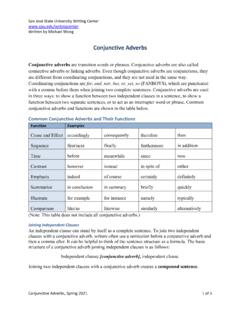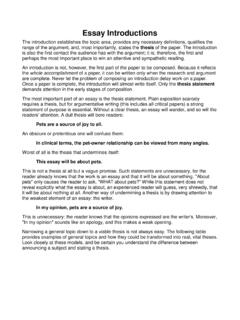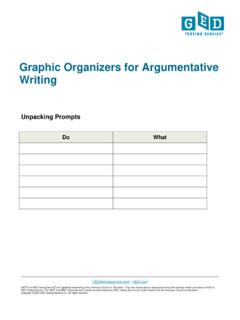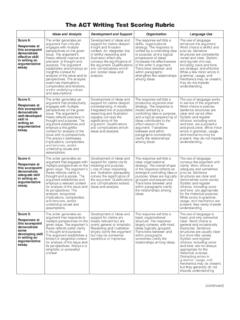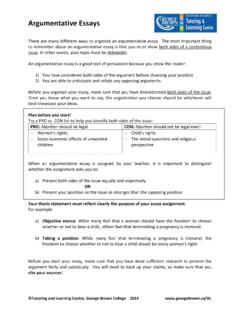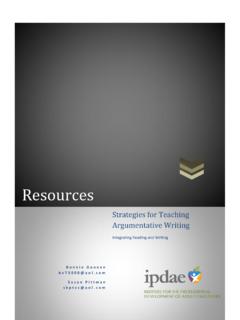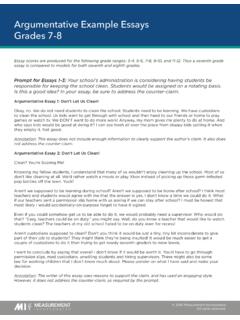Transcription of Essay Planning: Outlining with a Purpose
1 San Jos State University Writing Center Written by John Linford Outlining with a Purpose , Spring 2014. 1 of 4 Essay Planning: Outlining with a Purpose What Is an Outline? An outline is a direct and clear map of your Essay . It shows what each paragraph will contain, in what order paragraphs will appear, and how all the points fit together as a whole. Most outlines use bullet points or numbers to arrange information and convey points. Outlining is a vital part of the Essay planning process. It allows the writer to understand how he or she will connect all the information to support the thesis statement and the claims of the paper. It also provides the writer with a space to manipulate ideas easily without needing to write complete paragraphs. Outlining is a process that takes time and patience to perfect. It involves already having a working thesis statement and a general idea of an Essay theme. Outlining allows the writer not only to survey the information he or she is presenting, but also to plan how he or she will communicate with the audience.
2 Outlining allows the writer to experiment with style and tone to determine which presentation strategies are best. How Do I Develop an Outline? The first step to develop an outline is establishing a working thesis statement. After completing this step, you will have basic ideas for your body paragraphs. In addition, you should have already gathered the evidence you need to develop and support the claims in your paper. Sample Prompt Many societies believe that the pursuit of happiness is a fundamental human right, but it is also true that attainment of happiness remains elusive. Perhaps Bertrand Russell had it right when he said, "To be without some of the things you want is an indispensable part of happiness." What gives us more pleasure and satisfaction: the pursuit of our desires or the attainment of them? Write a personal Essay in which you draw on your own experiences, observations, and reading to discuss your answer to the question posed by the prompt.
3 An effective Essay will construct an argument that accounts for the complexity of the opening truth statement even as it weighs specific examples of pursuit and attainment to arrive at its conclusion. Step One: Select Your Format and Input Basic Ideas Determine if you want to use numbers, bullet points, or another style of outline. After choosing your format, look at your working thesis for the Essay theme and body paragraph topics. The prompt above is from the " Essay Planning: How to Develop a Working Thesis Statement" handout, in which we developed the following working thesis statement: "The thrill of pursuing happiness, the experiences along the way, and the knowledge that comes from trial and error provide people with more pleasure and satisfaction than the mere attainment of desires, despite the common perception that attainment is the final goal." Use the working thesis statement to develop basic paragraph order and format.
4 Outlining with a Purpose , Spring 2014. 2 of 4 This outline uses the information from the working thesis statement to establish a basic structure for the Essay . The supporting arguments from the working thesis statement have been composed into topic sentences for each paragraph. In addition, the conclusion now contains a qualified point from the working thesis statement. The topic sentences are repetitive in the first draft of the outline only to increase the simplicity of the example. As the outline develops, and in outlines for actual assignments, the topic sentences should specifically support your thesis statement, but they need not include this much repetition. Indeed, as you generate an outline, you can begin to see the relationships between ideas and state them more succinctly. The first topic sentence might be rewritten now to say, "The thrill of pursuing happiness may allow us to attain desires, but more importantly provides us the pleasure and satisfaction of the chase itself.
5 " Step Two: Add Supporting Information and Begin to Develop a Paragraph After establishing your basic outline, begin to add supporting details that support each topic sentence. Remember that these details must support the thesis statement. Also, begin to consider possible transition sentences between paragraphs. The following example develops just one paragraph from the basic outline we created above. Introduction oHook oWorking thesis statement: The thrill of pursuing happiness, the experiences along the way, and the knowledge that comes from trial and error provide people with more pleasure and satisfaction than the mere attainment of desires, despite the common perception that attainment is the final goal. Body paragraph one: The thrill of pursuing happiness oTopic sentence: The thrill of pursuing happiness provides people with more pleasure and satisfaction than merely attaining desires. Body paragraph two: Experiences while pursuing happiness oTopic sentence: The experiences gained from pursuing happiness provide people with more pleasure and satisfaction than merely attaining desires.
6 Body paragraph three: The knowledge that comes from trial and error oTopic sentence: The knowledge that comes from trial and error provides people with more pleasure and satisfaction than merely attaining desires. Conclusion oSynthesized point: Because of the thrill of pursuing happiness, the experiences along the way, and the knowledge gained from trial and error, the attainment of goals is less satisfying than many believe. Outlining with a Purpose , Spring 2014. 3 of 4 Body paragraph one: The thrill of pursuing happiness oTopic sentence: The thrill of pursuing happiness provides people with more pleasure and satisfaction than merely attaining desires. oCounterargument: However, some believe that attaining desires is the final source of happiness, and it does not matter how one gets it, so the thrill of pursuing happiness is irrelevant. oSupporting information: Small gains along the way add together to create more happiness than just the attainment.
7 Setting and reaching minor goals provides experience for the future when you try something similar, which will bring even more happiness. Many less important desires are attained along the way, and each one provides the happiness from both pursuing and attaining it. oTransition sentence: In addition to the The outline of the paragraph has been expanded to develop basic supporting information. It will use personal experiences, observations, and readings to accomplish this task, as required by the prompt. In addition, the transition sentence shows how that the paragraph idea fits into the next topic and even connects into the conclusion. The outline allows the writer to preview and rehearse the contents of the Essay before drafting. Step Three: Elaborate on Supporting Information and Include Essay Details At this point, you have enough information in your outline to construct a strong paragraph. If you are writing an argumentative Essay , include the counterargument and how you will refute it.
8 If you are writing a persuasive Essay , include the facts/statistics that you will use to persuade your audience. If you are writing an opinion Essay , state your opinion and how it is relevant. Because the prompt for this example states the Essay is argumentative , the outline includes a counterargument following the topic sentence. This counterargument will be included in this body paragraph of the Essay . After it, the supporting information works to both refute the counterargument and support the topic sentence and thesis statement. The counterargument is rough, so it will need to be developed in more detail in the Essay . As the Essay develops, the writer may find depending on how much detail is needed to explain each of the supporting claims the paragraph could be split into more than one paragraph supporting this one point about the thrill of the pursuit. Body paragraph one: The thrill of pursuing happiness oTopic sentence: The thrill of pursuing happiness provides people with more pleasure and satisfaction than merely attaining desires.
9 OSupporting information: Small gains along the way Setting and reaching minor goals Many less important desires attained along the way oTransition sentence: In addition to the thrill of the chase, people enjoy the experiences that occur along the way. Outlining with a Purpose , Spring 2014. 4 of 4 Conclusion oRestate main points: The thrill of pursuing happiness provides people with more pleasure and satisfaction than merely attaining desires. The experiences gained from pursuing happiness provide people with more pleasure and satisfaction than merely attaining desires. The knowledge that comes from trial and error provides people with more pleasure and satisfaction than merely attaining desires. oSynthesized point: Attaining goals provides some happiness. However, because of the thrill of pursuing happiness, the experiences along the way, and the knowledge gained from trial and error, the attainment of goals is less satisfying than many believe.
10 This process should be repeated for each body paragraph, again keeping in mind that any one main point may be expanded, if needed, into more than one paragraph to explain the evidence fully. Step Four: Consider How You Will Conclude Your Paper The concluding paragraph of your paper should tie together all your points to draw a logical conclusion from the evidence you have discussed. The example this handout has used is for an argumentative Essay . Usually, these essays conclude by restating the main points as well as synthesizing a new point that includes the thesis statement and counterargument. Although the main audience is those who agree with the main point, you still need to have considered those who disagree with you. By creating a synthesized conclusion, you create consensus between the two groups. Remember that your conclusion may change as you write your paper and process the specific information you have gathered into paragraphs.


